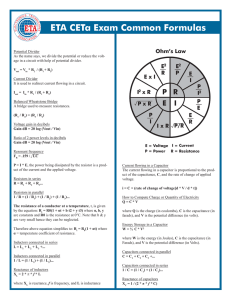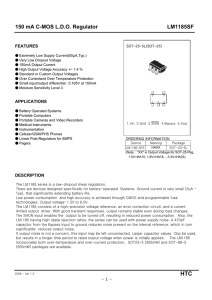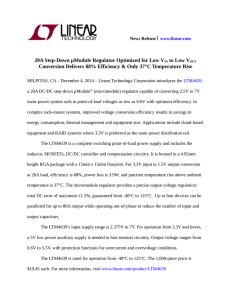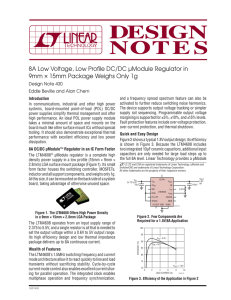LM317L 3-Terminal Adjustable Regulator
advertisement
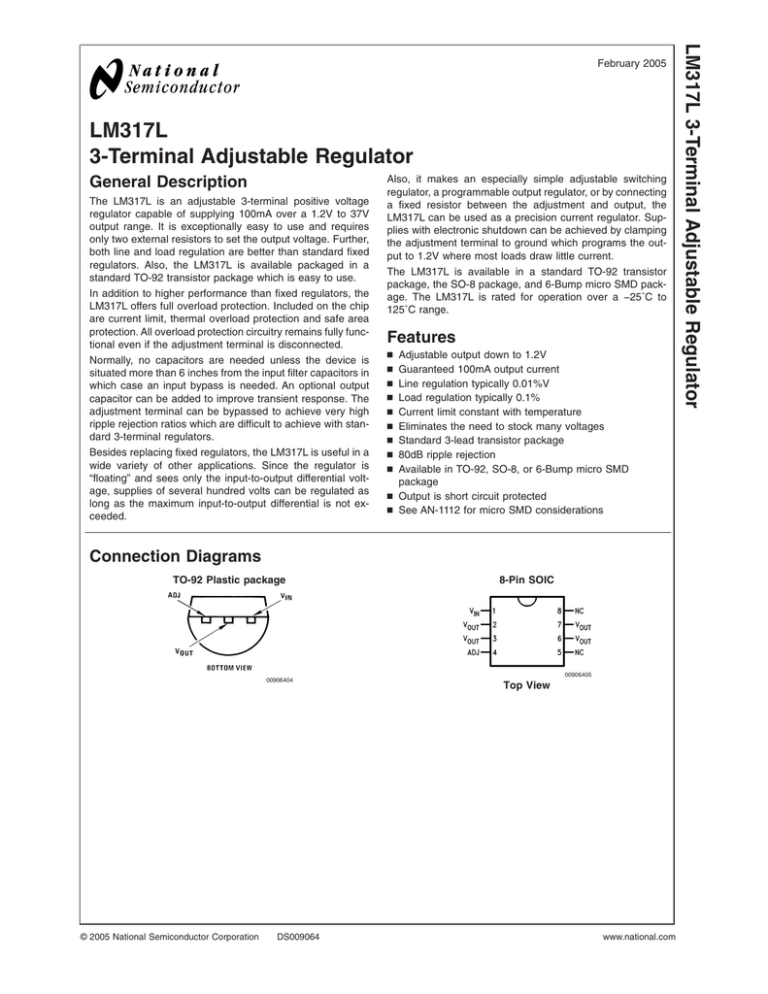
LM317L 3-Terminal Adjustable Regulator General Description The LM317L is an adjustable 3-terminal positive voltage regulator capable of supplying 100mA over a 1.2V to 37V output range. It is exceptionally easy to use and requires only two external resistors to set the output voltage. Further, both line and load regulation are better than standard fixed regulators. Also, the LM317L is available packaged in a standard TO-92 transistor package which is easy to use. In addition to higher performance than fixed regulators, the LM317L offers full overload protection. Included on the chip are current limit, thermal overload protection and safe area protection. All overload protection circuitry remains fully functional even if the adjustment terminal is disconnected. Normally, no capacitors are needed unless the device is situated more than 6 inches from the input filter capacitors in which case an input bypass is needed. An optional output capacitor can be added to improve transient response. The adjustment terminal can be bypassed to achieve very high ripple rejection ratios which are difficult to achieve with standard 3-terminal regulators. Besides replacing fixed regulators, the LM317L is useful in a wide variety of other applications. Since the regulator is “floating” and sees only the input-to-output differential voltage, supplies of several hundred volts can be regulated as long as the maximum input-to-output differential is not exceeded. Also, it makes an especially simple adjustable switching regulator, a programmable output regulator, or by connecting a fixed resistor between the adjustment and output, the LM317L can be used as a precision current regulator. Supplies with electronic shutdown can be achieved by clamping the adjustment terminal to ground which programs the output to 1.2V where most loads draw little current. The LM317L is available in a standard TO-92 transistor package, the SO-8 package, and 6-Bump micro SMD package. The LM317L is rated for operation over a −25˚C to 125˚C range. Features Adjustable output down to 1.2V Guaranteed 100mA output current Line regulation typically 0.01%V Load regulation typically 0.1% Current limit constant with temperature Eliminates the need to stock many voltages Standard 3-lead transistor package 80dB ripple rejection Available in TO-92, SO-8, or 6-Bump micro SMD package n Output is short circuit protected n See AN-1112 for micro SMD considerations n n n n n n n n n Connection Diagrams TO-92 Plastic package 00906404 © 2005 National Semiconductor Corporation DS009064 8-Pin SOIC 00906405 Top View www.national.com LM317L 3-Terminal Adjustable Regulator February 2005 LM317L Connection Diagrams (Continued) 6-Bump micro SMD micro SMD Laser Mark 00906450 00906449 *NC = Not Internally connected. Top View (Bump Side Down) Ordering Information Package Part Number Package Marking Media Transport NSC Drawing TO-92 LM317LZ LM317LZ 1.8k Units per Box Z03A 8-Pin SOIC LM317LM LM317LM Rails M08A 6-Bump micro SMD * LM317LIBP – 250 Units Tape and Reel * LM317LIBPX – 3k Units Tape and Reel Note: The micro SMD package marking is a single digit manufacturing Date Code only. www.national.com 2 BPA06HPB Storage Temperature If Military/Aerospace specified devices are required, please contact the National Semiconductor Sales Office/ Distributors for availability and specifications. Lead Temperature (Soldering, 4 seconds) Power Dissipation 40V Operating Junction Temperature Range −40˚C to +125˚C 260˚C Output is Short Circuit Protected Internally Limited Input-Output Voltage Differential −55˚C to +150˚C ESD Susceptibility Human Body Model (Note 5) 2kV Electrical Characteristics (Note 2) Parameter Conditions Min Typ Max Units %/V Line Regulation TJ = 25˚C, 3V ≤ (VIN − VOUT) ≤ 40V, IL ≤ 20mA (Note 3) 0.01 0.04 Load Regulation TJ = 25˚C, 5mA ≤ IOUT ≤ IMAX, (Note 3) 0.1 0.5 % Thermal Regulation TJ = 25˚C, 10ms Pulse 0.04 0.2 %/W 50 100 µA 5mA ≤ IL ≤ 100mA 0.2 5 µA 1.25 1.30 V Adjustment Pin Current Adjustment Pin Current Change 3V ≤ (VIN − VOUT) ≤ 40V, P ≤ 625mW Reference Voltage 3V ≤ (VIN − VOUT) ≤ 40V, (Note 4) Line Regulation 3V ≤ (VIN − VOUT) ≤ 40V, IL ≤ 20mA (Note 3) 0.02 0.07 %/V Load Regulation 5mA ≤ IOUT ≤ 100mA, (Note 3) 0.3 1.5 % 5 mA 1.20 5mA ≤ IOUT ≤ 100mA, P ≤ 625mW Temperature Stability TMIN ≤ TJ ≤ TMax 0.65 Minimum Load Current (VIN − VOUT) ≤ 40V 3.5 Current Limit 3V ≤ (VIN − VOUT) ≤ 13V 100 (VIN − VOUT) = 40V 25 3V ≤ (VIN − VOUT) ≤ 15V % 1.5 2.5 200 300 mA 50 150 mA Rms Output Noise, % of VOUT TJ = 25˚C, 10Hz ≤ f ≤ 10kHz Ripple Rejection Ratio VOUT = 10V, f = 120Hz, CADJ = 0 Long-Term Stability TJ = 125˚C, 1000 Hours 0.3 Thermal Resistance Z Package 0.4" Leads 180 ˚C/W Junction to Ambient Z Package 0.125 Leads 160 ˚C/W SO-8 Package 165 ˚C/W 6-Bump micro SMD 290 ˚C/W CADJ = 10µF 66 0.003 % 65 dB 80 dB 1 % Note 1: “Absolute Maximum Ratings” indicate limits beyond which damage to the device may occur. Operating Ratings indicate conditions for which the device is functional, but do not guarantee specific performance limits. Note 2: Unless otherwise noted, these specifications apply: −25˚C ≤ Tj ≤ 125˚C for the LM317L; VIN − VOUT = 5V and IOUT = 40mA. Although power dissipation is internally limited, these specifications are applicable for power dissipations up to 625mW. IMAX is 100mA. Note 3: Regulation is measured at constant junction temperature, using pulse testing with a low duty cycle. Changes in output voltage due to heating effects are covered under the specification for thermal regulation. Note 4: Thermal resistance of the TO-92 package is 180˚C/W junction to ambient with 0.4" leads from a PC board and 160˚C/W junction to ambient with 0.125" lead length to PC board. Note 5: The human body model is a 100pF capacitor discharged through a 1.5kΩ resistor into each pin. 3 www.national.com LM317L Absolute Maximum Ratings (Note 1) LM317L Typical Performance Characteristics (Output capacitor = 0µF unless otherwise noted.) Load Regulation Current Limit 00906434 00906435 Adjustment Current Dropout Voltage 00906436 00906437 Reference Voltage Temperature Stability Minimum Operating Current 00906438 www.national.com 00906439 4 Ripple Rejection (Continued) Ripple Rejection 00906441 00906440 Output Impedance Line Transient Response 00906442 00906443 Load Transient Response Thermal Regulation 00906444 00906445 5 www.national.com LM317L Typical Performance Characteristics (Output capacitor = 0µF unless otherwise noted.) LM317L Although the LM317L is stable with no output capacitors, like any feedback circuit, certain values of external capacitance can cause excessive ringing. This occurs with values between 500pF and 5000pF. A 1µF solid tantalum (or 25µF aluminum electrolytic) on the output swamps this effect and insures stability. Application Hints In operation, the LM317L develops a nominal 1.25V reference voltage, VREF, between the output and adjustment terminal. The reference voltage is impressed across program resistor R1 and, since the voltage is constant, a constant current I1 then flows through the output set resistor R2, giving an output voltage of LOAD REGULATION The LM317L is capable of providing extremely good load regulation but a few precautions are needed to obtain maximum performance. The current set resistor connected between the adjustment terminal and the output terminal (usually 240Ω) should be tied directly to the output of the regulator rather than near the load. This eliminates line drops from appearing effectively in series with the reference and degrading regulation. For example, a 15V regulator with 0.05Ω resistance between the regulator and load will have a load regulation due to line resistance of 0.05Ω x IL. If the set resistor is connected near the load the effective line resistance will be 0.05Ω (1 + R2/R1) or in this case, 11.5 times worse. Figure 2 shows the effect of resistance between the regulator and 240Ω set resistor. Since the 100µA current from the adjustment terminal represents an error term, the LM317L was designed to minimize IADJ and make it very constant with line and load changes. To do this, all quiescent operating current is returned to the output establishing a minimum load current requirement. If there is insufficient load on the output, the output will rise. With the TO-92 package, it is easy to minimize the resistance from the case to the set resistor, by using two separate leads to the output pin. The ground of R2 can be returned near the ground of the load to provide remote ground sensing and improve load regulation. 00906407 FIGURE 1. EXTERNAL CAPACITORS An input bypass capacitor is recommended in case the regulator is more than 6 inches away from the usual large filter capacitor. A 0.1µF disc or 1µF solid tantalum on the input is suitable input bypassing for almost all applications. The device is more sensitive to the absence of input bypassing when adjustment or output capacitors are used, but the above values will eliminate the possibility of problems. The adjustment terminal can be bypassed to ground on the LM317L to improve ripple rejection and noise. This bypass capacitor prevents ripple and noise from being amplified as the output voltage is increased. With a 10µF bypass capacitor 80dB ripple rejection is obtainable at any output level. Increases over 10µF do not appreciably improve the ripple rejection at frequencies above 120Hz. If the bypass capacitor is used, it is sometimes necessary to include protection diodes to prevent the capacitor from discharging through internal low current paths and damaging the device. In general, the best type of capacitors to use is solid tantalum. Solid tantalum capacitors have low impedance even at high frequencies. Depending upon capacitor construction, it takes about 25µF in aluminum electrolytic to equal 1µF solid tantalum at high frequencies. Ceramic capacitors are also good at high frequencies; but some types have a large decrease in capacitance at frequencies around 0.5MHz. For this reason, a 0.01µF disc may seem to work better than a 0.1µF disc as a bypass. www.national.com 00906408 FIGURE 2. Regulator with Line Resistance in Output Lead THERMAL REGULATION When power is dissipated in an IC, a temperature gradient occurs across the IC chip affecting the individual IC circuit components. With an IC regulator, this gradient can be especially severe since power dissipation is large. Thermal regulation is the effect of these temperature gradients on output voltage (in percentage output change) per watt of power change in a specified time. Thermal regulation error is independent of electrical regulation or temperature coefficient, and occurs within 5ms to 50ms after a change in power dissipation. Thermal regulation depends on IC layout as well as electrical design. The thermal regulation of a voltage regulator is defined as the percentage change of VOUT, per watt, within the first 10ms after a step of power is applied. The LM317L specification is 0.2%/W, maximum. In the Thermal Regulation curve at the bottom of the Typical Performance Characteristics page, a typical LM317L’s output changes only 7mV (or 0.07% of VOUT = −10V) when a 1W pulse is applied for 10ms. This performance is thus well inside the specification limit of 0.2%/W x 1W = 0.2% maxi6 the output of the regulator. The discharge current depends on the value of the capacitor, the output voltage of the regulator, and the rate of decrease of VIN. In the LM317L, this discharge path is through a large junction that is able to sustain a 2A surge with no problem. This is not true of other types of positive regulators. For output capacitors of 25 µF or less, the LM317L’s ballast resistors and output structure limit the peak current to a low enough level so that there is no need to use a protection diode. (Continued) mum. When the 1W pulse is ended, the thermal regulation again shows a 7mV change as the gradients across the LM317L chip die out. Note that the load regulation error of about 14mV (0.14%) is additional to the thermal regulation error. PROTECTION DIODES When external capacitors are used with any IC regulator it is sometimes necessary to add protection diodes to prevent the capacitors from discharging through low current points into the regulator. Most 10µF capacitors have low enough internal series resistance to deliver 20A spikes when shorted. Although the surge is short, there is enough energy to damage parts of the IC. When an output capacitor is connected to a regulator and the input is shorted, the output capacitor will discharge into The bypass capacitor on the adjustment terminal can discharge through a low current junction. Discharge occurs when either the input or output is shorted. Internal to the LM317L is a 50Ω resistor which limits the peak discharge current. No protection is needed for output voltages of 25V or less and 10µF capacitance. Figure 3 shows an LM317L with protection diodes included for use with outputs greater than 25V and high values of output capacitance. 00906409 D1 protects against C1 D2 protects against C2 FIGURE 3. Regulator with Protection Diodes micro SMD does not sustain permanent damage from light exposure. Removing the light source will cause LM317L’s VREF to recover to the proper value. LM317L micro SMD Light Sensitivity Exposing the LM317L micro SMD package to bright sunlight may cause the VREF to drop. In a normal office environment of fluorescent lighting the output is not affected. The LM317 7 www.national.com LM317L Application Hints www.national.com 8 Schematic Diagram 00906410 LM317L LM317L Typical Applications Slow Turn-On 15V Regulator Digitally Selected Outputs 00906415 Adjustable Regulator with Improved Ripple Rejection 00906411 *Sets maximum VOUT High Gain Amplifier 00906416 †Solid tantalum *Discharges C1 if output is shorted to ground High Stability 10V Regulator 00906412 Adjustable Current Limiter 00906413 12 ≤ R1 ≤ 240 Precision Current Limiter 00906417 00906414 9 www.national.com LM317L Typical Applications (Continued) Regulator With 15mA Short Circuit Current Adjustable Regulator with Current Limiter 00906420 00906418 Short circuit current is approximately 600 mV/R3, or 60mA (compared to LM317LZ’s 200mA current limit). Power Follower At 25mA output only 3/4V of drop occurs in R3 and R4. 0V–30V Regulator 00906421 00906419 Full output current not available at high input-output voltages Adjusting Multiple On-Card Regulators with Single Control* 00906422 *All outputs within ± 100mV †Minimum load −5mA www.national.com 10 (Continued) 5V Logic Regulator with Electronic Shutdown* 100mA Current Regulator 00906426 *Minimum output ≈ 1.2V 00906423 1.2V–12V Regulator with Minimum Program Current Current Limited 6V Charger 00906424 *Minimum load current ≈ 2 mA 50mA Constant Current Battery Charger for Nickel-Cadmium Batteries 00906427 *Sets peak current, IPEAK = 0.6V/R1 **1000µF is recommended to filter out any input transients. 00906425 11 www.national.com LM317L Typical Applications LM317L Typical Applications (Continued) Short Circuit Protected 80V Supply 00906428 Basic High Voltage Regulator 00906429 Q1, Q2: NSD134 or similar C1, C2: 1µF, 200V mylar** *Heat sink www.national.com 12 LM317L Typical Applications (Continued) Precision High Voltage Regulator 00906430 Q1, Q2: NSD134 or similar C1, C2: 1µF, 200V mylar** *Heat sink **Mylar is a registered trademark of DuPont Co. Tracking Regulator Regulator With Trimmable Output Voltage 00906432 Trim Procedure: — If VOUT is 23.08V or higher, cut out R3 (if lower, don’t cut it out). — Then if VOUT is 22.47V or higher, cut out R4 (if lower, don’t). — Then if VOUT is 22.16V or higher, cut out R5 (if lower, don’t). This will trim the output to well within ± 1% of 22.00 VDC, without any of the expense or uncertainty of a trim pot (see LB-46). Of course, this technique can be used at any output voltage level. 00906431 A1 = LM301A, LM307, or LF13741 only R1, R2 = matched resistors with good TC tracking 13 www.national.com LM317L Typical Applications (Continued) Precision Reference with Short-Circuit Proof Output 00906433 *R1–R4 from thin-film network, Beckman 694-3-R2K-D or similar Fully Protected (Bulletproof) Lamp Driver 1.2V-25 Adjustable Regulator 00906402 00906401 Lamp Flasher Full output current not available at high input-output voltages †Optional — improves transient response *Needed if device is more than 6 inches from filter capacitors 00906403 Output rate — 4 flashes per second at 10% duty cycle www.national.com 14 LM317L Physical Dimensions inches (millimeters) unless otherwise noted SO-8 Molded Package NS Package Number M08A TO-92 Plastic Package (Z) NS Package Number Z03A 15 www.national.com LM317L 3-Terminal Adjustable Regulator Physical Dimensions inches (millimeters) unless otherwise noted (Continued) NOTE: UNLESS OTHERWISE SPECIFIED. 1. EPOXY COATING 2. 63Sn/37Pb EUTECTIC BUMP. 3. RECOMMEND NON-SOLDER MASK DEFINED LANDING PAD. 4. PIN A1 IS ESTABLISHED BY LOWER LEFT CORNER WITH RESPECT TO TEXT ORIENTATION PINS ARE NUMBERED COUNTERCLOCKWISE. 5. XXX IN DRAWING NUMBER REPRESENTS PACKAGE SIZE VARIATION WHERE X1 IS PACKAGE WIDTH, X2 IS PACKAGE LENGTH AND X3 IS PACKAGE HEIGHT. 6. REFERENCE JEDEC REGISTRATION MO-211, VARIATION BC. 6-Bump micro SMD NS Package Number BPA06HPB X1 = 0.955 X2 = 1.615 X3 =0.850 National does not assume any responsibility for use of any circuitry described, no circuit patent licenses are implied and National reserves the right at any time without notice to change said circuitry and specifications. For the most current product information visit us at www.national.com. LIFE SUPPORT POLICY NATIONAL’S PRODUCTS ARE NOT AUTHORIZED FOR USE AS CRITICAL COMPONENTS IN LIFE SUPPORT DEVICES OR SYSTEMS WITHOUT THE EXPRESS WRITTEN APPROVAL OF THE PRESIDENT AND GENERAL COUNSEL OF NATIONAL SEMICONDUCTOR CORPORATION. As used herein: 1. Life support devices or systems are devices or systems which, (a) are intended for surgical implant into the body, or (b) support or sustain life, and whose failure to perform when properly used in accordance with instructions for use provided in the labeling, can be reasonably expected to result in a significant injury to the user. 2. A critical component is any component of a life support device or system whose failure to perform can be reasonably expected to cause the failure of the life support device or system, or to affect its safety or effectiveness. BANNED SUBSTANCE COMPLIANCE National Semiconductor manufactures products and uses packing materials that meet the provisions of the Customer Products Stewardship Specification (CSP-9-111C2) and the Banned Substances and Materials of Interest Specification (CSP-9-111S2) and contain no ‘‘Banned Substances’’ as defined in CSP-9-111S2. National Semiconductor Americas Customer Support Center Email: new.feedback@nsc.com Tel: 1-800-272-9959 www.national.com National Semiconductor Europe Customer Support Center Fax: +49 (0) 180-530 85 86 Email: europe.support@nsc.com Deutsch Tel: +49 (0) 69 9508 6208 English Tel: +44 (0) 870 24 0 2171 Français Tel: +33 (0) 1 41 91 8790 National Semiconductor Asia Pacific Customer Support Center Email: ap.support@nsc.com National Semiconductor Japan Customer Support Center Fax: 81-3-5639-7507 Email: jpn.feedback@nsc.com Tel: 81-3-5639-7560
